Toyota Camry sedans of the 1994 model year were produced both with right-hand drive and left-hand drive. The European market received used cars from Japan, belonging to the generation V30 (produced until the end of July 1994) or the subsequent generation V40. The V30 series did not have any differences from the previous model year, and the Toyota Camry with the new body was equipped with several types of engines ranging from 1.8 to 2.2 liters.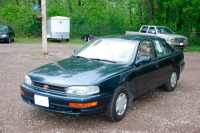 The interior is rather "sad": plastic of blue tones, pale violet and purple upholstery of seats and doors. The inserts in wood on the central console, around the dashboard and on the doors do little to save the picture. Such plain interior corresponds little to a car of the so-called business class (to which our guest belongs also).
The interior is rather "sad": plastic of blue tones, pale violet and purple upholstery of seats and doors. The inserts in wood on the central console, around the dashboard and on the doors do little to save the picture. Such plain interior corresponds little to a car of the so-called business class (to which our guest belongs also).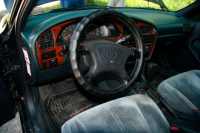 However, although not the most expensive materials are used in the interior design, the high quality of finishing is not in doubt. And in dimensions it corresponds to its class. For example, on back seats (with headrests and a big central armrest) a middle-sized person can sit comfortably: not touching the front seat backrest with his knees (even almost completely moved aside).
However, although not the most expensive materials are used in the interior design, the high quality of finishing is not in doubt. And in dimensions it corresponds to its class. For example, on back seats (with headrests and a big central armrest) a middle-sized person can sit comfortably: not touching the front seat backrest with his knees (even almost completely moved aside).
By the way, the backrest of the rear sofa can be folded down to increase the volume of the (already capacious) luggage compartment or to arrange sleeping places.
The front seats with good lateral support provide excellent body fixation, have a wide range of adjustments and allow you to settle down very comfortably. The feature of this station wagon is two additional passenger seats in the luggage compartment, equipped with seat belts.
Access to these seats is through the trunk door. By and large, they are intended only for children.
Specifications and equipment
The factory offered several levels of equipment for 1994:
Standard ZX (with front or all-wheel drive);
Improved Touring (front-wheel drive only);
Lumiere maximum (front or all-wheel drive);
diesel XJ (front-wheel drive only).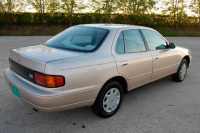 The list of standard equipment included:
The list of standard equipment included:
headlights with halogen bulbs and fog lights in the front bumper;
interior mirror with anti-glare coating;
windshield wipers with the rest area under the hood edge;
indicator for driver's seatbelt unbuckled;
illuminated ignition key;
driver and passenger sun visors with integrated mirrors;
spare tire with reduced tire and replacement tool kit;
luggage compartment light;
rear door child lock;
audible light reminder signal.
The base variant of the ZX car with the 1.8-liter engine was equipped with power windows for all doors with the ability to lock operation by a switch located on the driver's door. The locks were centrally electrically operated. A change of speed would unlock or lock all locks. The instrument cluster with tachometer, speedometer, and dial indicators for coolant temperature and fuel volume was located in front of the driver. Some models used an Optitron unit with dimmable backlighting.
The standard equipment included air conditioning with automatic mode and push-button control unit. The steering column had a fold-out glove box for small items, and the center of the instrument panel had retractable cupholders. Driver and front passenger seat belt upper anchor points were height adjustable. A front armrest was standard, and a rear recliner was not fitted except on the base ZX.
The cars kept the lever suspension in front and rear, supplemented by shock absorbers, cylindrical springs and anti-roll bars.
Brakes were equipped with ventilated discs in the front and drums in the rear (for the diesel version and modification with an engine capacity of 1.8 liters) or solid discs without slots for cooling. Rack and pinion steering was equipped with a hydraulic booster, and the column was manually adjustable for angle of installation.
Technical parameters of the machine:
body length - 4625 mm;
width - 1695 mm;
height - up to 1425 mm;
wheelbase - 2650 mm;
ground clearance - not more than 160 mm;
fuel tank capacity - 60 l.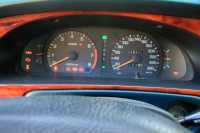 The driver's workplace is comfortable and functional; the ergonomics is well thought out. The dashboard, covered with a large visor, displays the necessary minimum of information, the scales are well readable. Rather large diameter, perfectly gripped steering wheel can be moved up and down, adjusting the angle of inclination of the column.
The driver's workplace is comfortable and functional; the ergonomics is well thought out. The dashboard, covered with a large visor, displays the necessary minimum of information, the scales are well readable. Rather large diameter, perfectly gripped steering wheel can be moved up and down, adjusting the angle of inclination of the column.
On the central console are located magnet and controls climate control with simple and clear symbols.
Looking at the Camry, hardly anyone would say, that this typical family station wagon can drive decently. But, as it turns out, it really can! The three-liter V-shaped six coupled with a very responsive automatic accelerates the car very quickly. Gearchanges change smoothly, almost imperceptibly, acceleration is powerful without lags.
With little effort on the gas pedal, the shift to higher gears takes place at about 2,000 rpm. And if you press the gas pedal, the automatic shifts to a lower gear only when the engine is cranked up to 6,000 rpm, and the Camry rushes forward.
On the straight sections of the road the soft long-stroke suspension provides the confident and reliable behavior of the car: it easily copes with both flat waves, and with hard joints. Even more serious pits and bumps the Toyota passes painlessly. Smoothness of running is excellent.
However, such suspension has also disadvantages: delayed reaction of the automobile to sharp turns of a steering wheel, body rolls and appreciable yaw with intensive braking, and rolls when passing abrupt turns.
However, smooth running for a car of this class is much more important than responsive and fast reactions.
Power steering for quiet maneuvering perfectly copes with its work and helps to feel the car on any road, not losing feedback from the car.
Noise isolation of the Camry is very good: only the faint sound of the engine and the barely audible rustle of the tires can be heard inside.
Engine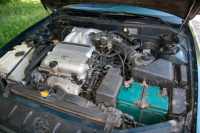 The standard version was equipped with a 125-horsepower 4S-FE engine, which had a capacity of 1.8 liters and was equipped with a 16-valve head with 2 camshafts. Electronically controlled injectors are used for fuel delivery. The exhaust system had a catalytic converter and oxygen sensors, which corrected the mixture. It was equipped with liquid cooling system with forced circulation and thermostat, which maintained the desired temperature. The engine was offered only with manual 5-speed transmission.
The standard version was equipped with a 125-horsepower 4S-FE engine, which had a capacity of 1.8 liters and was equipped with a 16-valve head with 2 camshafts. Electronically controlled injectors are used for fuel delivery. The exhaust system had a catalytic converter and oxygen sensors, which corrected the mixture. It was equipped with liquid cooling system with forced circulation and thermostat, which maintained the desired temperature. The engine was offered only with manual 5-speed transmission.
The life of the 3-liter engine before overhaul is about 500 thousand km. The timing belt should be replaced every 80,000 km, and the tensioner should be replaced as well.
On this six-cylinder engine, located in the engine compartment transversely, sometimes the cylinder head gasket leaks (the one closer to the cabin).
The weak point is the hydraulic engine supports. Their failure is evidenced by oil leaks on supports and increased vibration, transmitted to the body. Another typical malfunction is that with the time the exhaust casing is rubbed.
Failures of stepper motor of idling system were also noticed (winding burns out in it, and, as a consequence, the engine unstably operates at idling speed).
Car Safety
The safety of the car corresponded to the requirements for passenger cars in the first half of the 1990s. The body structure included deformable longitudinal members. In a frontal impact, the engine and box would fall down without damaging the engine shield. The doors had a power frame supplemented by steel crossmembers, but the protection from side impacts was insufficient. Fog lights were standard, with additional cornering lights.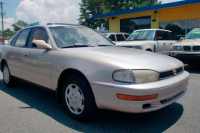 The standard equipment included an airbag for the driver. A front passenger airbag was offered as an option or was installed by default in more expensive versions. The brake actuation system included an ABS unit which supported electronic force distribution between the wheel calipers.
The standard equipment included an airbag for the driver. A front passenger airbag was offered as an option or was installed by default in more expensive versions. The brake actuation system included an ABS unit which supported electronic force distribution between the wheel calipers.
Driver and passenger seats were equipped with inertial seat belts. Padded, adjustable head restraints reduced the likelihood of injury in an accident.
Transmission
In general, the automatic transmission is a fairly reliable unit. Mostly breakdowns of the "automatic" occur at improper oil change. The fact is that every 60 thousand km it is necessary to change oil not only in the box itself, but also in its gearbox, as they have a separate lubrication system.
It is possible to check oil level with a dipstick only in a gearbox. Therefore, when operating a car with an automatic, it is necessary to constantly monitor the tightness of the gearbox, because oil from the gearbox may leak out, and the dipstick will have a normal level.
Chassis
Fully independent suspension Camry sufficiently energy-efficient, the car holds the road well, even in tight curves. In addition, the high weight and high directional stability of the car contribute to a confident ride at high speeds.
Stabilizer rods (front and rear) have an average life of about 30-40 thousand km. Stabilizer bushings last a bit longer - about 40-50 thousand km. After 60-80 thousand km, as a rule, the front arm silentblock needs to be replaced.
The weak point is the rear silentblock of longitudinal traction - it serves about 30-40 thousand km (and is designed to be replaced by the assembly with a hub). The front silentblock of a longitudinal rod serves somewhat longer and is replaced only in an assembly with a rod. The pads of rear shock absorbers are not eternal - their service life is approximately 60-80 thousand km.
Rack and pinion steering is equipped with hydraulic booster. At a mileage of about 250-300 thousand km the oil seals can leak in it.
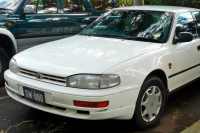

-rear-and-front-view-camera-6.png)

